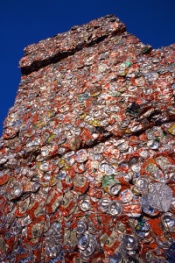Separating Recyclables from the Waste Stream

DEEP often receives questions and complaints regarding recycling programs which use a single collection container for both their disposed solid waste (trash), and their designated (mandatory) recyclables. These businesses, schools, government offices, homeowners, hospitals etc. have reportedly been told by their hauler that they do not need a separate container(s) for their designated recyclable items, and that their mixed material is delivered to a facility permitted to separate out the designated recyclable items. Such hauler claims are misleading and, consequently, any household, business, school, government office, etc. using this system for managing their designated recyclable items is in violation of state recycling separation requirements. Pursuant to CGS Section 22a-241b (as amended and clarified by Section 3 of Public Act 10-87), designated recyclable items must be separated from other solid waste and cannot be collected together with trash in the same collection container. Once separated, designated recyclable items cannot be mixed with other solid waste.
Recycling facilities process source separated recyclables collected in our communities and businesses and either market the material directly to manufacturers and paper mills or send the material to other recycling facilities for further processing. In order to help assure that designated recyclable items are actually recovered for recycling and used to make new products, these facilities can only accept source separated recyclables and should be generating only a minimum of residue. The technology employed by a recycling facility as well as the conditions of its solid waste permit and the prevailing market conditions will determine the type of recyclables a specific facility can process.
The design of the recycling collection and aggregation program for a business, institution, government office, etc. ideally should be based on the type, amount and composition of recyclable material generated and can take various forms ranging from:
- Separate containers for specific types of recyclables (e.g. separate cardboard collection dumpsters), to
- Containers that co-mingle some types of recyclables (e.g. bottles and cans in the same container), to
- Containers that mix all types of recyclables (e.g. single stream – bottles, cans, and paper in the same container).
Regardless of the type of recycling container(s) employed, or where the recyclables are being collected from, the recyclables cannot be mixed with trash in the same collection container.
For more information, call or write:
Connecticut Department of Energy and Environmental Protection
Bureau of Materials Management and Compliance Assurance
Recycling Program
79 Elm Street
Hartford, CT 06106-5127
Phone: (860) 424-3366
Content Last Updated January 2020

